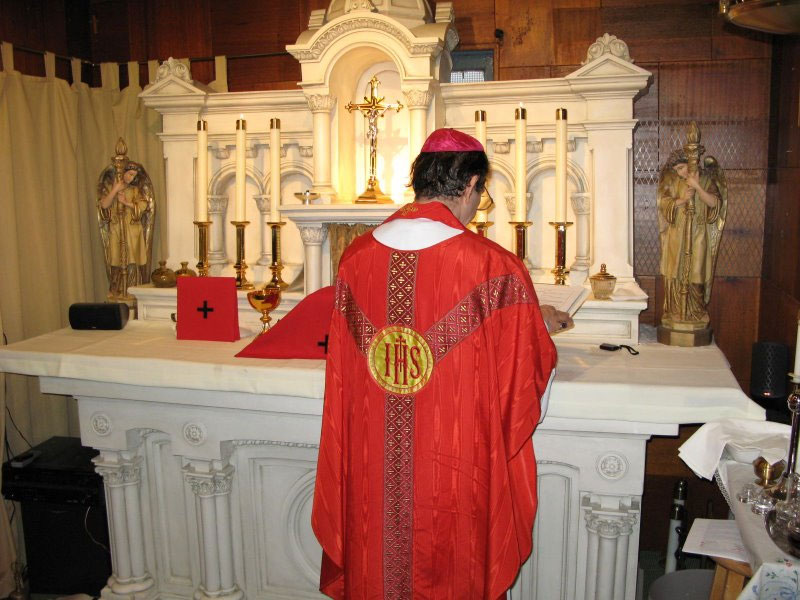Answered by Legionary of Christ Father Edward McNamara, professor of liturgy and dean of theology at the Regina Apostolorum university.
Q: I observe many priests presiding at daily and Sunday Masses in church wearing alb and stole but no chasuble. These are not situations of concelebration. Is it permissible to preside at Mass without wearing a chasuble? — T.P., Quebec
A: I think this question is sufficiently addressed in the instruction Redemptionis Sacramentum. To wit:
«123. The vestment proper to the Priest celebrant at Mass, and in other sacred actions directly connected with Mass unless otherwise indicated, is the chasuble, worn over the alb and stole. Likewise the Priest, in putting on the chasuble according to the rubrics, is not to omit the stole. All Ordinaries should be vigilant in order that all usage to the contrary be eradicated.
«124. A faculty is given in the Roman Missal for the Priest concelebrants at Mass other than the principal concelebrant (who should always put on a chasuble of the prescribed color), for a just reason such as a large number of concelebrants or a lack of vestments, to omit ‘the chasuble, using the stole over the alb.’ Where a need of this kind can be foreseen, however, provision should be made for it insofar as possible. Out of necessity, the concelebrants other than the principal celebrant may even put on white chasubles. For the rest, the norms of the liturgical books are to be observed.»
«126. «The abuse is reprobated whereby the sacred ministers celebrate Holy Mass or other rites without sacred vestments or with only a stole over the monastic cowl or the common habit of religious or ordinary clothes, contrary to the prescriptions of the liturgical books, even when there is only one minister participating. In order that such abuses be corrected as quickly as possible, Ordinaries should take care that in all churches and oratories subject to their jurisdiction there is present an adequate supply of liturgical vestments made in accordance with the norms.»
During the 1970s some countries received permission to use a combination chasuble cum alb with the stole worn over it. Although one still occasionally sees this somewhat ugly and ungainly vesture it has mostly disappeared.
The norms mentioned above are the most recent and reflect the current state of the question from the point of view of liturgical law.
* * *
Follow-up: The Part of Consecration at Mass
Pursuant to our May 1 article on the consecration some readers made further inquiries.
Two readers, from Ireland and Nigeria, asked similar questions: «Where is the directive found which eliminates ‘Mysterium Fidei’ in private/priests’ Masses?» And: «In view of the fact that the invitation and acclamation after the consecration are omitted, when priests celebrate/concelebrate alone, does it follow that the Agnus Dei, during the ‘fractio,’ is also omitted in these celebrations of the Eucharist?»
With respect to the actions of a priest who celebrates alone, I have stated my personal opinion in a reply from November 14, 2006.
In that article, I explain that there is no overall clear directive, but one must interpret the general principle that monitions directed toward the people are omitted.
For concelebration with only priests, there are clear directions to omit the Mysterium Fidei, but it would appear that the rest of the Mass is said as normal with the principal celebrant addressing his brother priests. Therefore the Agnus Dei is said or sung as normal.
Finally, an eagle-eyed Irish reader caught an apparent contradiction between some of my assertions and the photo which accompanied the May 1 article.
«I notice that the ZENIT editors have illustrated Father McNamara’s latest article (https://zenit.org/articles/the-part-of-consecration-at-mass/) with a photograph that in the foreground shows flowers on the mensa of the altar, perhaps of the Santa Marta chapel, at which Pope Francis is saying Mass, in spite of what Father McNamara says about the ‘clear preference’ of liturgy documents: https://zenit.org/articles/criteria-for-preparing-the-altar/ and https://zenit.org/articles/how-brides-should-dress/ andhttps://zenit.org/articles/decorating-the-sanctuary/.»
As our reader says, the photos are chosen by the editors, and they can be forgiven if they don’t remember everything I have written over the last 15 years.
If the photo was of a papal Mass, well, does it really make much of a difference?
The Pope is the Church’s supreme legislator, and if he wishes to give himself an exception to some minor liturgical rule, he can do so.
If he wants to make a permanent change to some aspect, he has multiple means of doing so: motu proprio, decree, or a letter to the Congregation for Divine Worship ordering a change of rules.
As far as I know, he has yet to use a photo as a legal instrument. There is no way of knowing if the image represents the will of the Supreme Pontiff or the liturgical taste of the sacristan at Santa Marta.
Therefore, until an official change is made to the liturgical books I will stick to what I have said in my previous articles.
* * *
Readers may send questions to zenit.liturgy@gmail.com. Please put the word «Liturgy» in the subject field. The text should include your initials, your city and your state, province or country. Father McNamara can only answer a small selection of the great number of questions that arrive.



